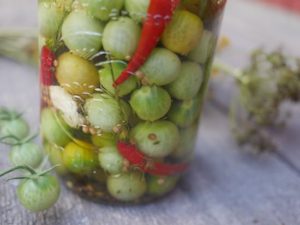Lacto-Fermented Green-Cherry Tomato Pickles
By Kirsten K. Shockey – Mother Earth News
Even the smallest garden—as in a few pots on a sunny windowsill—has a cherry tomato plant. They don’t ask for much and they give a lot. These bite-sized sweet tomatoes are the first to ripen and are therefore very exciting in late June or July when we are anticipating the fresh sweet homegrown tomato flavor. It’s soon over: one day in August the first slicer comes on and well, the cheery cherries start to loose their magic mostly because you just can’t keep up with them.
Don’t get me wrong—they are still tasty and easy and wonderful to pop in your mouth as you pass by the prolific plant, but they just keep coming. They are also a challenge to preserve in sauce or salsa since they are so small. I hate to waste good food, even tiny tomatoes, but when the big beefy slicers and paste tomatoes are on I ignore the little ones. Last year I came up with a strategy—get ‘em while they are green.
These become a fun little side to serve later in the year, when the fresh tomatoes are once again part of our summer dreams.
The trick with these tomato pickles is to not pick the smallest, hard, dense ones. Choose the fruits on the vine that are close to full size and while still green, are not white-green but verdant and headed toward ripenin.
Green Cherry Tomato Pickles
Prep time: 5 minutes
Wait time: 7 days of fermentation
Yield: 1 quart
Ingredients
• 2 pint baskets green cherry tomatoes, or enough to fill a quart jar to the shoulder
• 3 cloves garlic, whole, peeled and lightly crushed
• 1 small dried whole chili
• 2 tablespoons mustard seed
• 1 tablespoon coriander seed
• 1 tablespoon green peppercorns, black peppercorns work well also
• 1 grape leaf, optional
For the brine:
• 1 tablespoon unrefined salt
• 2 ½ cups unchlorinated water
Instructions
1. Place the garlic and spices in the bottom of the jar. Add the tomatoes, stop filling at the neck; it is okay if you have a little less.
2. Stir the salt into room temperature water and pour this brine over the top of the tomatoes until completely submerged. If using top with the grape leaf tuck it under at the edges, this will help keep the tomatoes from floating out of the brine. (Or, add a small fermentation weight.) Remember that under the brine everything is fine! Put any extra brine in the fridge to top off if needed during the fermentation process.
3. Put a lid on your jar (or a water lock lid if you have one) and screw it down. Instructions for a simple set up are here.
4. If you are using an airlock continue to step 6. (If you are curious about what that is click here.) If you are using a tightened lid, check it daily: when the lid starts to tighten when you press on it, open it slightly and you will hear a slight hiss as the gas escapes. If some brine bubbles out, do not worry—just replace with some of the reserved brine when it settles down, and make sure the tomatoes are all still submerged.
5. Keep your jar on a plate on the counter for about 7 days. At this point your brine should be cloudy and the ferment should smell nicely sour. Taste your pickles. They will be nicely soured; if you would like them more sour, tuck everything back in and let it ferment for another week or two. Manage it as described above. These will keep in the refrigerator for about 6 months.
Kirsten K. Shockey is a post-modern homesteader who lives in the mountains of Southern Oregon. She writes about sauerkraut and life—but not necessarily in that order. She’s written a complete book of Fermented Vegetables and maintains the website Ferment.works.


